Embark on the green journey by learning how to start a garden in the ground. Starting a backyard garden can be a fun and rewarding activity for everyone. Whether you want to grow your own vegetables, herbs, or flowers, it doesn’t have to be complicated. These easy steps will guide you through the process of starting a garden in the ground.
Key Takeaways
- Consider what you want to plant and start small
- Pick a sunny location with access to water
- Clear the ground and improve your soil
- Prepare your planting beds and pick suitable plants
- Plant seeds or young plants following the instructions
- Water your garden in the morning to reduce evaporation
Consider What to Plant
Decide what you want to grow in your garden, whether it’s vegetables, herbs, or flowers. Think about what your family likes to eat or what you want to use the herbs for. Start small until you get the hang of it.
Pick the Best Garden Spot
Choose a location in your yard that gets 6-8 hours of full sun each day. Look for a spot with access to water and consider the slope of the land, as well as its proximity to your house. If your yard is mostly shady, choose plants that prefer shade.
Clear the Ground
Remove weeds and grass in the area you plan to plant. You can use a shovel to cut out the sod or use the lasagna gardening method. Lasagna gardening involves layering newspaper over the grass and covering it with compost.
Test and Improve Your Soil
Have a soil test done to determine what your soil lacks and how to amend it. Add organic matter such as compost to improve the nutrient content and drainage of your soil.
Prepare Your Planting Beds
Loosen the soil in your garden bed using a rototiller or hand tools. Mix in the organic matter from Step 4 to improve soil structure. Avoid compacting the soil by walking on plywood boards.
Pick Your Plants
Choose plants that are adapted to your climate, soil, and sunlight. Some easy-to-grow plants for beginners include annuals like marigolds and zinnias, perennials like daylilies and black-eyed Susans, and vegetables like tomatoes and peppers.
Start Planting
Plant seeds directly in the garden or buy young plants from a nursery. Follow the instructions on the seed packets or plant tags for the correct planting time, depth, and spacing. Keep the soil moist but not wet.
Water at the Right Time
Set up an automatic watering system or use a hose to water your garden. Water in the morning when the temperature is cooler to reduce evaporation and fungal diseases.
By following these easy steps, you can start a garden in the ground and enjoy the rewards of your efforts with beautiful views, delicious flavors, and colorful blooms.
Consider What to Plant
Before starting your garden, it’s important to consider what you want to plant. Do you want a vegetable garden, an herb garden, or a flower garden? If you’re choosing vegetables and herbs, opt for ones that your family will eat. If you prefer flowers, decide between annuals that bloom all summer but need replanting, or perennials that return year after year. It’s advisable to start small until you’re more experienced.
Choosing the best spot for your garden is crucial. Most vegetables and flowers need 6-8 hours of full sun, so observe your yard to determine which areas receive full sun, partial shade, or full shade. Additionally, ensure your garden has easy access to a water source and pick a relatively flat spot to avoid complications.
Before planting, clear the ground of weeds and sod. You can either remove the sod manually by slicing under it with a spade or use the lasagna gardening method, which involves covering the area with newspaper or cardboard and layering compost or a potting soil and topsoil mixture on top.
Testing and improving your soil is essential. Have a soil test done to determine its composition and any necessary amendments. Residential soil usually needs a boost, so add organic matter like compost to enrich it.
Prepare your planting beds by loosening the soil, either by tilling with a mechanical device like a rototiller or by digging manually. Work the soil when it’s moist but not too wet or dry, and mix in the organic matter. Avoid compacting the soil by using plywood boards to distribute your weight.
Next, pick the plants you want to grow. Some easy-to-grow options for beginners include annuals like calendula and zinnias, perennials like black-eyed Susans and lamb’s ears, and vegetables like tomatoes and lettuce.
Once you’ve selected your plants, it’s time to start planting. Some plants, like pansies and kale, can tolerate cold weather and can be planted in autumn or late winter. Tomatoes and most annual flowers prefer warmer temperatures, so wait until the danger of frost has passed before planting them. You can sow seeds directly in the garden or start them indoors a few weeks before the last frost date.
Water your plants at the right time to ensure their health. It’s beneficial to set up an automatic watering system connected to a timer. For new plantings and seeds, hand-watering may be necessary.
When considering what to plant in your garden, think about your preferences and the maintenance requirements of different plants. Choose a suitable location with adequate sun exposure and access to water. Prepare the ground, improve the soil, and select the right plants for your climate and gardening goals. Remember to water your plants properly and enjoy the process of growing your own garden.
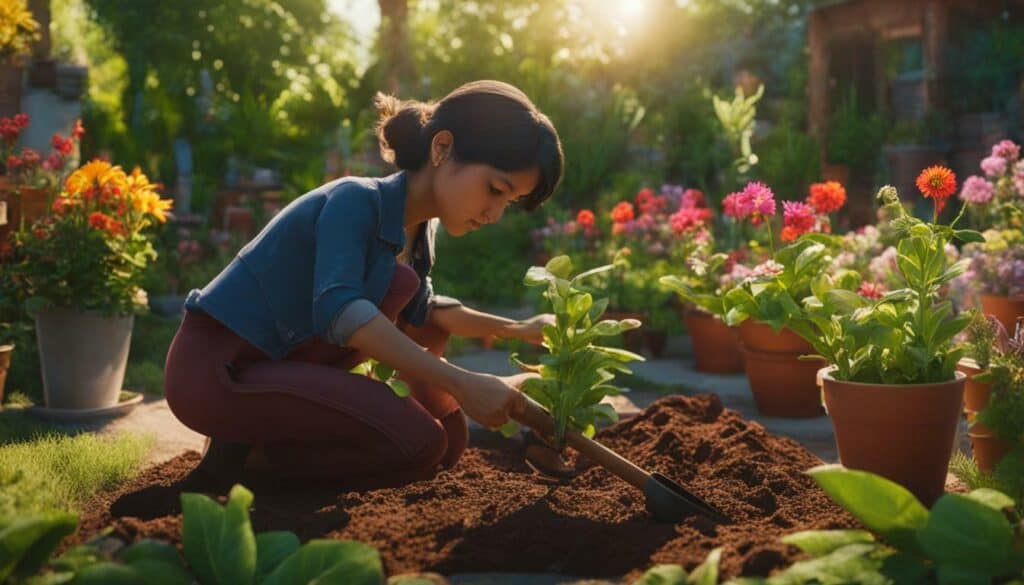
Pick the Best Garden Spot
The success of your garden largely depends on selecting the best spot for it. When choosing the location for your garden, consider a spot that receives 6-8 hours of full sun each day. Observe your yard to determine which areas are sunny versus shady. It’s also important to make sure the spot is easily accessible to a water source.
Before starting your garden, clear the ground by removing weeds and sod. You can either cut them out or use the lasagna gardening method, which involves layering cardboard or newspaper over the grass and covering it with soil and compost.
To ensure healthy plant growth, it’s crucial to test and improve your soil. Soil may lack essential nutrients and proper drainage, which can be improved by adding organic matter. Loosening the soil and preparing the planting beds are also necessary for easy root growth.
When picking plants, consider ones that are adapted to your climate, soil, and sunlight. Start planting at the appropriate times based on the plant’s tolerance to temperature. It’s also important to water your plants at the right time. Consider using an automatic watering system for convenience.
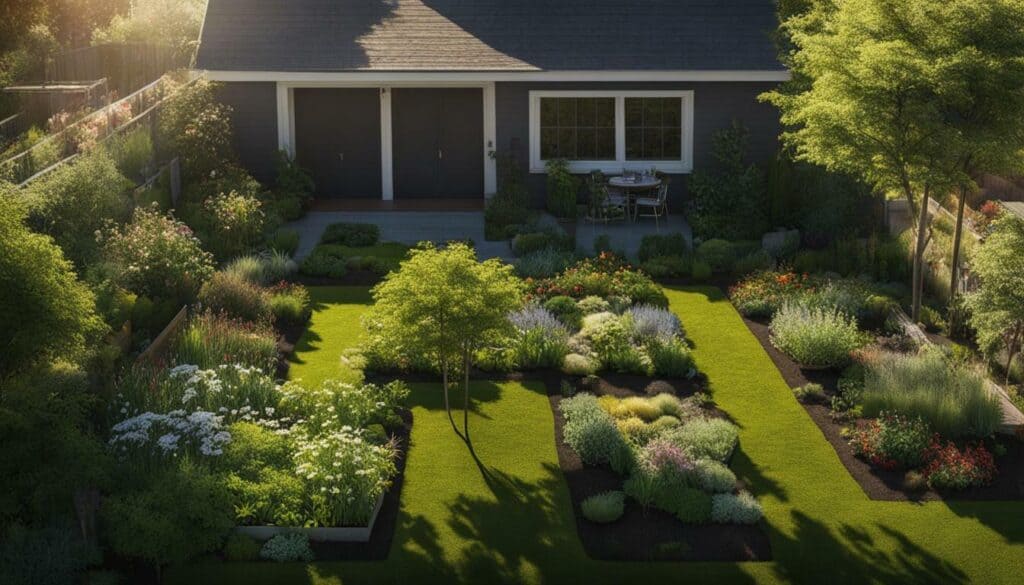
By following these tips for picking the best garden spot, clearing the ground, testing and improving your soil, preparing your planting beds, and picking the right plants, your garden will thrive. Harvest and enjoy the fruits of your gardening efforts!
Clear the Ground
Before you can start planting, you’ll need to clear the ground of any existing vegetation. This is an essential step in starting a garden, and there are different methods you can use to achieve it. If you’re short on time and want quick results, you can cut out the sod by slicing under it with a spade and removing the sections. Make sure to remove as much of the roots as possible to prevent regrowth. If you have more time and prefer a no-dig method, you can use the lasagna gardening technique.
To use the lasagna gardening method, start by covering the area with newspaper or cardboard to smother the weeds and grass. Then add layers of organic matter, such as compost, straw, leaves, and even shredded paper. Each layer should be about 2-3 inches thick. Continue layering until you reach a height of about 18-24 inches. The layers will break down over time, creating a nutrient-rich bed that’s ready to plant with no grass or weeds.
Once the ground is cleared, it’s important to test and improve the soil in your garden. You can have a soil test done through your county cooperative extension office to determine what your soil lacks and how to amend it. Adding organic matter, such as compost, is usually recommended to boost the nutrient levels in the soil. It also improves soil structure and drainage, which is essential for healthy plants.
Now that the ground is cleared and the soil is prepared, you can start planting your desired plants or seeds. It’s important to choose plants that are adapted to your climate, soil, and sunlight. You can start with easy-to-grow plants for beginners, such as annuals like calendula and zinnias, perennials like Black-eyed Susans and purple coneflowers, and vegetables like tomatoes and peppers. Proper watering and care for your garden are also crucial for successful growth. It’s recommended to set up a watering system, such as a battery-operated timer connected to a soaker hose or drip line, to ensure consistent watering. Regularly visit your garden to check for any issues and harvest the fruits of your labor. Remember to pick young and often to encourage more production.

By following these steps, you can successfully clear the ground and start your own garden. With a little bit of effort and patience, you can enjoy the benefits of fresh produce, beautiful flowers, and a peaceful outdoor space.
Test and Improve Your Soil
Understanding your soil’s nutrient levels and improving them is crucial for a successful garden. Before planting, it’s important to test your soil to determine its fertility and any deficiencies it may have. You can have a soil test done through your county cooperative extension office or use a DIY kit for a general idea.
Testing your soil is the first step in improving it. Adding organic matter to your soil can provide essential nutrients and improve drainage, ensuring that your plants thrive. Compost is an excellent source of organic matter. You can make your own compost by collecting yard waste and kitchen scraps, such as fruit and vegetable peels, eggshells, and coffee grounds.
| Ground Gardening Tips |
|---|
| Tip 1: Mix compost into your soil before planting to improve soil structure and fertility. |
| Tip 2: Add gypsum to clay soil to improve drainage, or add peat moss or vermiculite to sandy soil to increase water retention. |
| Tip 3: Mulch your garden beds with organic matter, such as leaves or straw, to reduce weed growth and retain moisture. |
Preparing your soil properly before planting will give your plants the best chance to grow and produce a bountiful harvest. This involves loosening the soil and mixing in organic matter like compost. You can use a garden fork or tiller to help loosen the soil. Avoid over-tilling as this can lead to soil compaction.
Improving your soil is an ongoing process. Adding organic matter every year will help maintain healthy soil. You can also consider cover cropping, which involves planting crops like clover or rye in the off-season to add organic matter and prevent erosion.
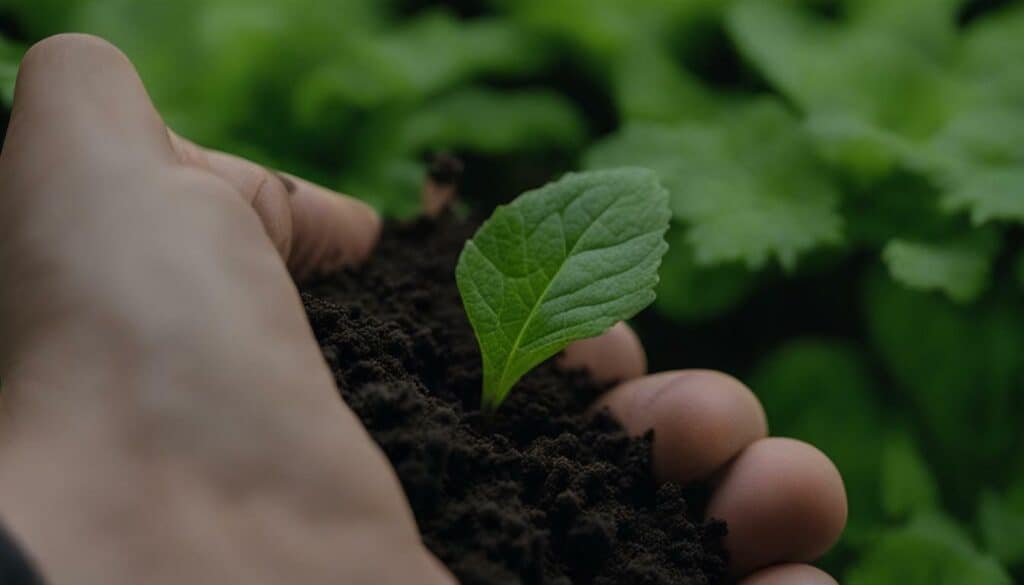
Prepare Your Planting Beds
Before you can start planting, it’s important to prepare your planting beds. This involves several important steps to ensure successful gardening.
First, consider what you want to plant – vegetables, herbs, or flowers – and choose based on your preferences and maintenance requirements. It’s important to select plants that are suitable for the climate and soil conditions in your area.
Next, select the best spot in your yard that receives at least 6-8 hours of full sun each day and has easy access to a water source. This will help ensure that your plants receive the necessary sunlight and water to thrive.
Clear the ground by removing weeds and sod, either by cutting it out or using the lasagna gardening method. This will help prevent competition from unwanted plants and ensure that your plants have adequate room to grow.
Test and improve the soil by having a soil test done and adding organic matter such as compost. This will help provide your plants with the necessary nutrients and improve drainage.
Prepare your planting beds by loosening the soil either by tilling with a mechanical device or digging by hand, and mixing in the organic matter. This will provide a loose and aerated soil that’s ideal for plant growth.
Finally, pick your plants based on your climate, soil, and sunlight conditions, and start planting at the right time. Remember to water at the right time and care for your garden daily, and enjoy harvesting and eating the fruits of your labor.
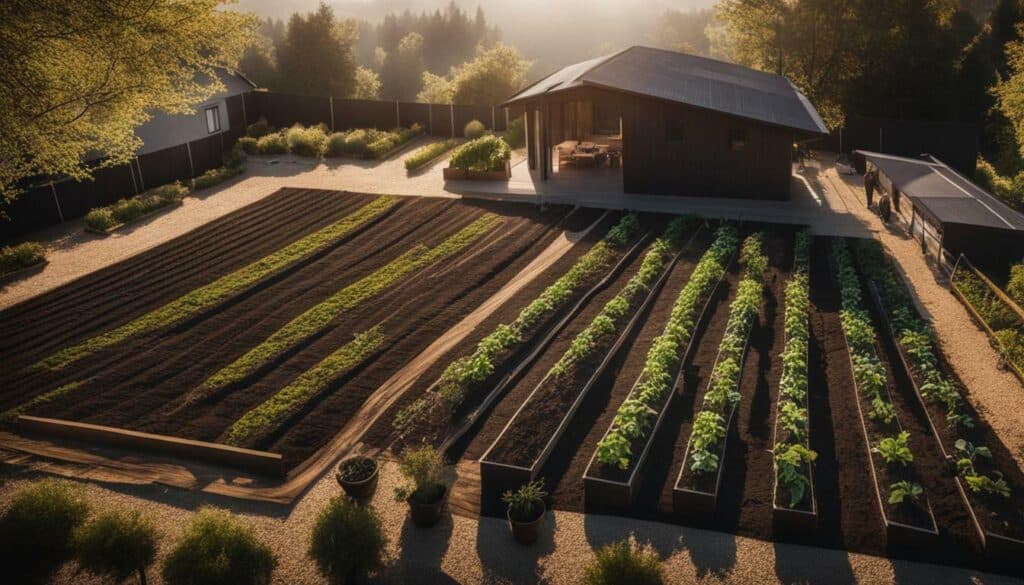
Preparing your planting beds is an essential step in ensuring a successful garden. With proper planning and preparation, you can create a beautiful and bountiful garden that you can enjoy for years to come.
Pick Your Plants
Now comes the fun part – choosing the plants for your garden! When deciding what to plant, consider what you want out of your garden. Are you interested in growing vegetables, herbs, or flowers? If you opt for vegetables, choose ones that your family enjoys eating and that thrive in your region. For flowers, decide between annuals that bloom for one season or perennials that return year after year.
It’s best to start small and gradually expand. Take into account the location of your garden, as most plants require 6-8 hours of sunlight. Choose a spot with easy access to a water source to make watering easier.
Clear the ground of weeds and sod by either cutting it out or using the lasagna gardening method. Once the ground is ready, it’s time to test and improve the soil. A simple soil test can be done by sending a sample to a lab or using a DIY kit. This will help you determine the pH balance and nutrient levels of your soil. Once you know what you’re dealing with, you can add organic matter like compost or mulch to improve fertility and drainage.
Before sowing or planting, prepare the planting beds by loosening the soil. When it comes to picking your plants, choose varieties adapted to your climate, soil, and sunlight. Some easy-to-grow plants for beginners include calendula, cosmos, and tomatoes. Timing of planting depends on the type of plants and the climate. Be sure to water the garden at the right time to ensure healthy growth.
By considering all these factors, you can select the right plants for your garden. Don’t be afraid to try new things and experiment until you find what works best for you. Happy planting!
Start Planting
It’s finally time to start planting in your garden! Follow these steps to ensure your plants get off to a strong start:
1. Consider What to Plant
First, decide what you want to plant in your garden. Consider vegetables, herbs, flowers, or a combination of all three. Choose plants that are suitable for your climate and soil type, and that will thrive in the amount of sunlight your garden receives.
2. Choose the Best Location
Choose the best location for your garden, preferably one that gets 6-8 hours of full sun each day and has easy access to a water source. Ensure that the garden spot has flat terrain and adequate drainage.
3. Clear the Ground
Prepare the ground by removing weeds and sod. You can either manually cut out the grass or use the newspaper and compost method (lasagna gardening). Layer newspaper over the grass and cover it with compost. The grass will break down and provide nutrients for your soil.
4. Improve Your Soil
Test your soil to determine what organic matter it needs to become more fertile. Add compost, manure, or other organic matter to your soil to improve its structure and promote better drainage.
5. Prepare Your Planting Beds
Prepare your planting beds by loosening the soil and adding organic matter like compost. Mix the organic matter thoroughly into the soil to ensure it is well-distributed throughout the bed.
6. Pick Your Plants
Choose plants that are suitable for your climate, soil, and sunlight conditions. Consider easy-to-grow plants for beginners, such as tomatoes, peppers, cucumbers, herbs, and flowers.
7. Start Planting
Plant seeds directly in the ground or start young plants indoors and transplant them into the prepared planting beds. Ensure that you water your plants consistently, taking into consideration their individual needs.
Starting a backyard garden is a rewarding experience that doesn’t have to be difficult. Follow these simple steps to get your garden off to a great start and enjoy the many benefits of homegrown plants and produce!
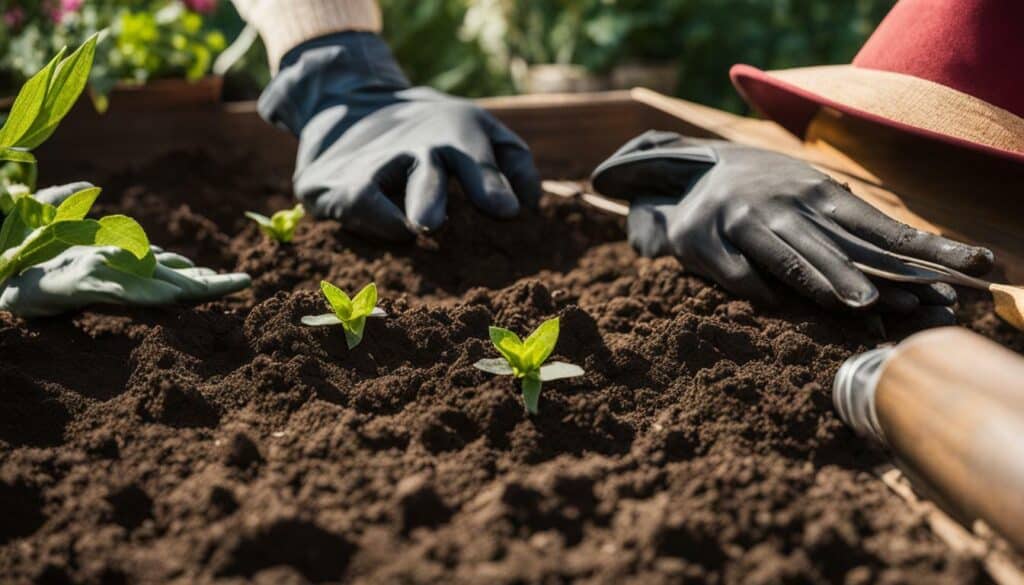
Conclusion
Follow these easy steps to start a garden in the ground and enjoy the rewards of fresh produce and beautiful blooms. Starting a garden in your backyard can be a satisfying and rewarding experience. By selecting the right location and preparing the soil properly, you can create an environment that is conducive to growing healthy plants. Choose plants that are suited to your climate and sunlight conditions, and observe them closely for signs of pests or disease. Be consistent with watering and maintenance, and you’ll soon see the fruits (and vegetables) of your labor.
Don’t be afraid to experiment and try out new techniques and plants as you become more experienced. Keep learning and growing your knowledge of gardening. With dedication and effort, your backyard garden can become a source of pride and enjoyment for years to come.
So, grab your shovel and gloves and get started on your backyard gardening adventure today. With these ground gardening tips, you’ll be well on your way to growing beautiful plants and enjoying the fresh produce from your own garden.
FAQ
Q: What should I consider when starting a garden in the ground?
A: When starting a garden in the ground, it’s important to consider what you want to plant, whether it’s vegetables, herbs, or flowers. Choose plants that your family will enjoy and start with a small garden until you feel more confident.
Q: How do I pick the best spot for my garden?
A: Look for a location that gets 6-8 hours of full sun each day and is close to a water source. It’s also helpful to choose a relatively flat area for easy gardening.
Q: How do I clear the ground before planting?
A: To clear the ground, remove weeds and sod in the area you plan to plant. You can either cut out the sod or use the lasagna gardening method by covering the area with newspaper and compost to create a weed-free planting bed.
Q: How do I test and improve my soil?
A: Have a soil test done to understand your soil’s nutrient levels. You can improve your soil’s fertility and drainage by adding organic matter, such as compost. Work the soil when it’s moist but not too wet or dry.
Q: How do I prepare my planting beds?
A: Before sowing or planting, loosen the soil in your beds to promote root growth. You can use a mechanical device like a rototiller or dig by hand. Mixing in organic matter will also help enrich the soil.
Q: What plants should I choose for my garden?
A: Choose plants that are adapted to your climate, soil, and sunlight conditions. For beginners, consider easy-to-grow plants like calendula, cosmos, cucumber, lettuce, peppers, and tomatoes. You can purchase young plants or start from seeds.
Q: How do I start planting in the ground?
A: You can plant seeds directly in the garden or sow them indoors a few weeks before the last frost date. Follow the instructions on the seed packet for planting depth and spacing. If using young plants, untangle any root-bound roots and transplant them into the prepared beds.
Q: When and how should I water my garden?
A: You can install an automatic watering system or use a hose to water your garden. Consider using a battery-operated timer connected to a soaker hose or drip line. Water at the right time to keep plants hydrated but not over-watered.
Can Your Ultimate Guide to Gardening also help me with starting a garden in the ground?
If you’re looking for guidance on starting a traditional garden in the ground, the ultimate gardening guide can certainly be of assistance. This comprehensive resource covers various gardening techniques, including tips on soil preparation, plant selection, and care. Whether you’re a beginner or experienced gardener, the ultimate gardening guide provides valuable information to help you create and maintain a thriving garden.
Source Links
- https://growitbuildit.com/how-to-start-a-vegetable-garden-in-your-backyard/
- https://www.bhg.com/gardening/yard/garden-care/ten-steps-to-beginning-a-garden/
- https://growinginthegarden.com/gardening-for-beginners-how-to-start-a-garden-in-8-simple-steps/
- https://www.thespruce.com/how-to-start-a-garden-from-scratch-2132778
- https://bonnieplants.com/blogs/garden-fundamentals/how-to-plant-an-in-ground-garden-its-easy
- https://sebsnjaesnews.rutgers.edu/2020/04/choosing-the-right-location-for-your-vegetable-garden/
- https://www.gardensthatmatter.com/choose-garden-location/
- https://www.almanac.com/where-put-vegetable-garden
- https://www.almanac.com/how-remove-grass-garden-bed
- https://www.almanac.com/soil-preparation-how-do-you-prepare-garden-soil-planting
- https://joegardener.com/how-to-improve-your-soil-3-simple-steps-for-making-any-soil-better/
- https://growagoodlife.com/improve-garden-soil/
- https://www.creativevegetablegardener.com/prepping-spring-garden-beds/
- https://www.provenwinners.com/learn/make-your-bed
- https://getbusygardening.com/prepare-vegetable-garden-for-planting/
- https://www.almanac.com/vegetable-gardening-for-beginners
- https://blog.nationwide.com/family-life/travel-outdoors/tips-for-planting-garden/
- https://harpersnurseries.com/how-to-build-garden-plot/
- https://content.ces.ncsu.edu/home-vegetable-gardening-a-quick-reference-guide

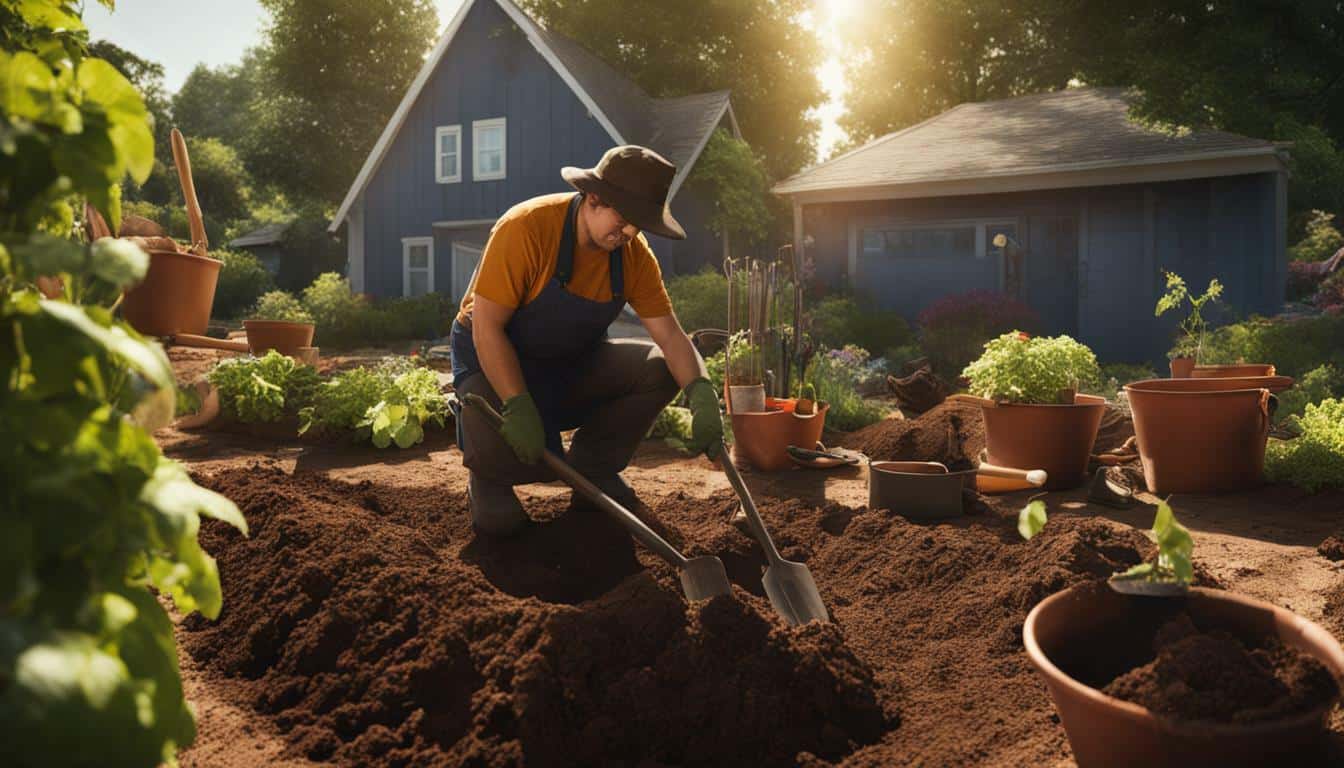



Leave a Reply